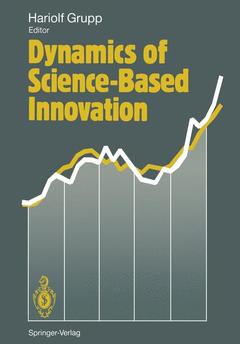Dynamics of Science-Based Innovation, Softcover reprint of the original 1st ed. 1992
Langue : Français
Coordonnateur : Grupp Hariolf

This volume intends to give an insight into progress in the field of studies on modern science and technology. Researchers from Sweden, Japan and Germany began a "three country comparative study" in 1984. One of the primary aims of this study group was to better take account of the increasing importance of Japan in both analytical work and technology policy. To this end, researchers from the Research Policy Institute (RPI) at the University of Lund, the Graduate School of Policy Science at Saitama University in Urawa, and the Fraunhofer Institute for Systems and Innovation Research in Karlsruhe met almost every year with policy makers from the three countries, in order to see how well the scientific debate is reflected in the interests of practitioneers in the related policies. The cooperation with the Swedish Board for Technical Development (STU)!, the Japanese Ministry of Education, Science and Culture (Monbusho), and the German Federal Ministry for Research and Technology (BMFT) brought about numerous "grey" papers, publications and two volumes of seminar proceedings. The first book2 deals with the problems of measuring technological change and summarizes tentative research plans from our first meetings. I concluded then, in November 1986, that "quantitative results are to be checked in a qualitative discursive process with the involved people. ( . . . ) The interaction of various indicators raises the pressure of argument and credibility. Case studies in dynamic fields of technology ideally supplement quantitative approaches.
I Concepts and New Methodology.- 1 By way of introduction Alliances between science research and innovation research.- 1.1 Historic background and research questions nowadays.- 1.2 A cognitive model.- 1.3 From models to science policy and innovation management.- 2 Technology as an autonomous socio-cognitive system.- 2.1 Introduction.- 2.2 Differentiation of technology as a socio-cognitive system.- 2.3 Functional integration of the socio-cognitive system of technology.- 2.4 Concluding comments.- 3 A special mediation between science and technology When inventors publish scientific articles in fuel cells research.- 3.1 Introduction.- 3.2 What fuel cell patents filed in France count and tell.- 3.3 Articles cited on the front page of the patents in B: Fuel cell research does exist.- 3.4 Articles published by inventors: When science and technology intermingle.- 3.5 Conclusion.- 4 Perceptions of scientification of innovation as measured by referencing between patents and papers Dynamics in science-based fields of technology.- 4.1 Introduction and state of the art.- 4.2 Methodology and data.- 4.3 Fundamental characteristics of science involvement in technology.- 4.4 International development panorama.- 4.5 Sectoral tableau of science involvement in Germany.- 4.6 Conclusions.- II Changes in National Science and Innovation Systems.- 5 Linking science and innovation in East Germany — a fiasco?.- 5.1 A macroview on R&D in the former German Democratic Republic.- 5.2 Links between academic and industrial research: A microview.- 5.3 Discussion and assessment of science-related innovation in East Germany.- 6 Linking science and innovation in Japan — a success?.- 6.1 The role of universities in Japan.- 6.2 Separation of research from education.- 6.3 Opening universities to industry and the general public.- 6.4 Popularization of graduate school education.- 6.5 Future perspectives.- 7 Molecular beam epitaxy — a mesoview of Japanese research organization.- 7.1 Introduction.- 7.2 Sketch of MBE technology and its development.- 7.3 Evolution of the institutional structure of MBE research in Japan.- 7.4 Conclusions.- III Crossroads in Selected Technologies: Case Studies.- 8 Knowledge expansion in applied science A bibliometric study of laser medicine and polyimide chemistry.- 8.1 Introduction.- 8.2 General methodology.- 8.3 Data collection.- 8.4 Exploration of the field of polymer research.- 8.5 Trends in polyimide research.- 8.6 Exploration of the field of laser research.- 8.7 Trends in laser medicine research.- 8.8 Conclusions.- 9 At the crossroads in laser medicine and polyimide chemistry Patent assessment of the expansion of knowledge.- 9.1 Introduction.- 9.2 Meaning of citations in patent search reports.- 9.3 Selection of case studies and abstract of historic events in laser and polyimide evolution.- 9.4 Cyclicity of laser and polyimide development.- 9.5 Science-technology relation in laser medicine and polyimides in electronics.- 9.6 Technological knowledge expansion in laser medicine and polyimides in electronics.- 9.7 Conclusions for corporate R&D management and science policy.- 10 Mapping an evolving technology cluster The composition and structure of factory automation.- 10.1 Introduction.- 10.2 Conceptual approach.- 10.3 Composition and structure of factory automation technology.- 10.4 Concluding remarks.- IV Discussion.- 11 Analysing links between science, technology and innovation State of the art in science research and in innovation research.- 11.1 Why this chapter?.- 11.2 Concepts and new methodology.- 11.3 Changes in national science and innovation systems.- 11.4 Crossroads in selected technologies: Case studies.- 11.5 Conclusions: State of the art in science and innovation research.- List of figures.- List of tables.- Bibliographic sketch of contributors.
Date de parution : 10-2013
Ouvrage de 371 p.
17x24.4 cm
Disponible chez l'éditeur (délai d'approvisionnement : 15 jours).
Prix indicatif 105,49 €
Ajouter au panierThèmes de Dynamics of Science-Based Innovation :
Mots-clés :
Trend; automation; display; innovation; innovation policy; Engineering Economics
© 2024 LAVOISIER S.A.S.


